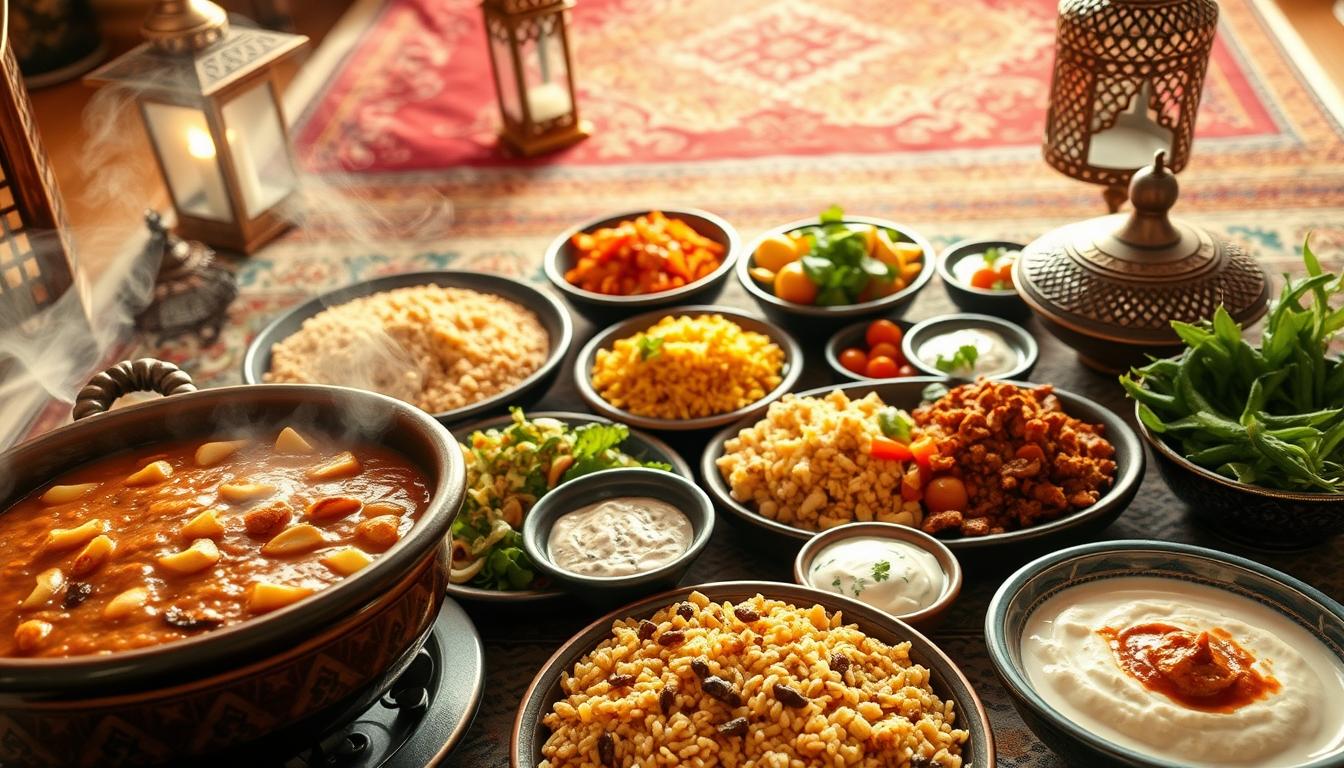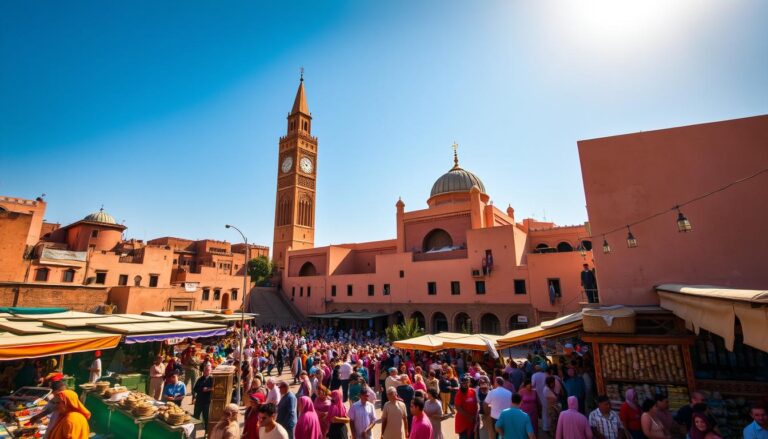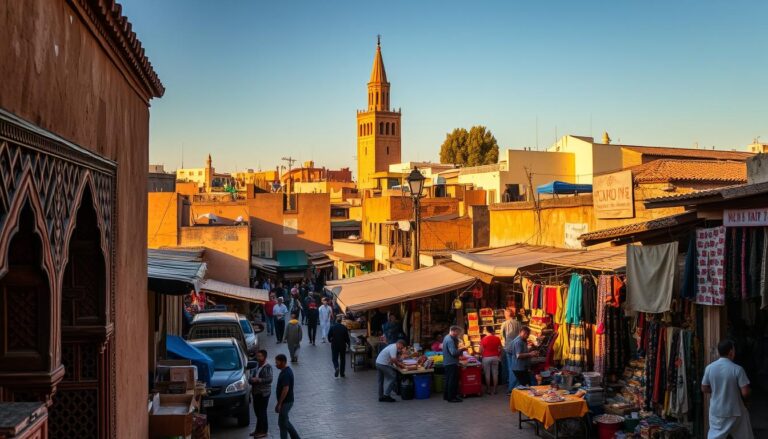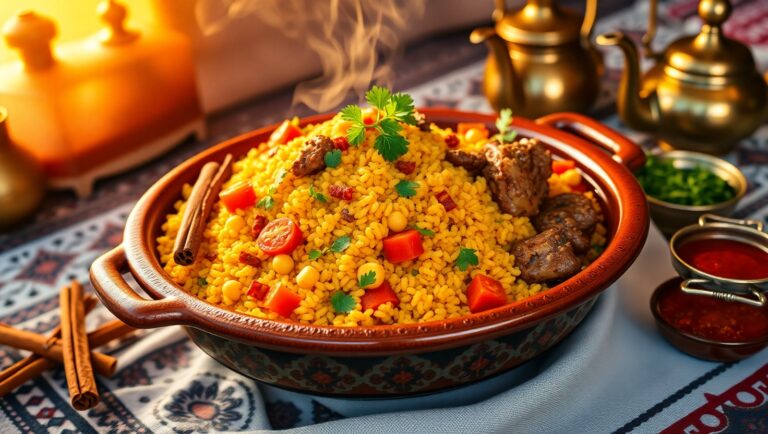Moroccan Food: A Flavorful Cultural Experience
Embark on a culinary journey through the vibrant world of Moroccan cuisine, where the flavors are as diverse as the country’s history and geography. This North African food is a reflection of the rich cultural heritage, blending Berber, Arab, and Mediterranean influences.
The result is a complex and aromatic culinary experience that is both exotic and accessible, making it a fascinating topic for cultural culinary experience enthusiasts. With its unique blend of flavors and spices, Moroccan cuisine offers a sensory journey that is sure to delight.
Key Takeaways
- Moroccan cuisine is a reflection of the country’s diverse history and geography.
- It blends Berber, Arab, and Mediterranean influences.
- The cuisine offers a complex and aromatic culinary experience.
- It is a fascinating topic for cultural culinary experience enthusiasts.
- Moroccan cuisine is both exotic and accessible.
The Rich Heritage of Moroccan Cuisine
Morocco’s strategic position has made its cuisine a crossroads of Berber, Arab, and Mediterranean flavors. This blend of culinary traditions has resulted in a rich gastronomic heritage.
Berber, Arab, and Mediterranean Influences
The Berber cuisine, one of the oldest influences on Moroccan food, contributes hearty dishes and preservation techniques. The Arab influence introduced sophisticated culinary practices and exotic spices, while the Mediterranean diet brought an emphasis on olive oil, citrus, and fresh vegetables. As
“Moroccan cuisine is a delicious blend of Berber, Arab, and Mediterranean cuisines, reflecting the country’s cultural diversity.”
The Historical Spice Routes and Colonial Impact
Morocco’s history as a hub on the spice routes has significantly shaped its cuisine, with the trade of spices like cumin, coriander, and cinnamon. The colonial period further diversified Moroccan cuisine, introducing new ingredients and cooking techniques from Europe. Today, Moroccan cuisine stands as a testament to its complex history, blending traditional flavors with international influences.
- Spice trade introduced new flavors
- Colonial period added European cooking techniques
- Blend of traditional and international cuisines
What Makes Moroccan Food Unique
With a history influenced by various cultures, Moroccan cuisine offers a distinct gastronomic experience that reflects its rich heritage. The blend of Berber, Arab, and Mediterranean influences has resulted in a unique culinary identity.
Flavor Profiles and Aromatic Combinations
Moroccan cuisine is characterized by its complex flavor profiles and aromatic combinations. The use of a wide range of spices, including cumin, coriander, cinnamon, and ginger, creates a depth of flavor that is both intriguing and satisfying.
The combination of these spices with herbs like parsley, cilantro, and mint adds to the aromatic richness of the dishes.
The art of blending spices is a hallmark of Moroccan cooking, with each region having its own signature blends. Ras el hanout, a mix of over 30 spices, is a prime example of this culinary expertise.
Balance of Sweet and Savory
A distinctive feature of Moroccan cuisine is its balance of sweet and savory flavors. This balance is achieved by combining ingredients like dried fruits, honey, and sugar with meats, vegetables, and spices. The result is a harmonious blend that tantalizes the taste buds.
Dishes like tagine with prunes and chicken or lamb with apricots exemplify this balance, showcasing the unique ability of Moroccan cuisine to marry seemingly disparate flavors into a cohesive and delicious whole.
Essential Ingredients in Moroccan Cooking
Understanding the essential ingredients in Moroccan cooking is key to unlocking the secrets of this complex and aromatic cuisine. Moroccan dishes are known for their rich flavors, which are achieved through the use of a variety of traditional ingredients.
Signature Spices and Herbs
Moroccan cuisine is characterized by its bold use of spices and herbs. Ras el Hanout, a blend of numerous spices, is a staple in many Moroccan recipes.
Ras el Hanout and Spice Blends
Ras el Hanout, which translates to “head of the shop,” is a complex mix of spices that can include cinnamon, cumin, coriander, and turmeric, among others. This blend adds depth and warmth to dishes like tagines and couscous.
Fresh Herbs in Moroccan Cuisine
Fresh herbs such as parsley, cilantro, and mint are commonly used to add freshness and flavor to Moroccan dishes. They are often used as garnishes or mixed into salads and sauces.
Staple Grains and Legumes
Grains and legumes form the backbone of Moroccan cuisine. Couscous, made from semolina flour, is a staple grain, while lentils, chickpeas, and fava beans are commonly used legumes.
| Ingredient | Common Use |
|---|---|
| Couscous | Main dish, often served with vegetables and meat |
| Lentils | Soups and stews |
| Chickpeas | Salads and stews |
Preserved Lemons and Unique Condiments
Preserved lemons are a distinctive ingredient in Moroccan cooking, adding a salty, tangy flavor to dishes. They are often used in tagines and salads.
Moroccan cuisine’s rich flavor profile is largely due to its use of a wide range of ingredients, from spices and herbs to grains and condiments. Understanding these essential ingredients is crucial for recreating authentic Moroccan dishes.
Traditional Cooking Methods and Tools
Traditional cooking methods play a crucial role in defining the unique flavors of Moroccan dishes. The country’s culinary heritage is characterized by slow cooking techniques and the use of specialized cooking vessels that have been passed down through generations.
The slow cooking process allows for the rich flavors of the ingredients to meld together, creating the distinctive taste profiles that Moroccan cuisine is known for. Two of the most significant elements in traditional Moroccan cooking are the tagine and clay ovens.
The Tagine: Morocco’s Iconic Cooking Vessel
The tagine is a clay pot with a conical lid that is emblematic of Moroccan cooking. This unique vessel allows for the slow cooking of stews and tagines (the dishes are named after the pot), enabling the flavors to concentrate and the meat to become tender. The conical lid of the tagine allows the steam to rise, condense, and then drop back into the dish, creating a moist and flavorful environment.

Clay Ovens and Slow Cooking Techniques
Clay ovens, or afar, are another crucial element in traditional Moroccan cooking. These ovens are used for slow cooking a variety of dishes, including bread and stews. The slow cooking process in clay ovens enhances the flavors of the ingredients and results in tender, fall-apart textures.
| Cooking Method | Description | Typical Dishes |
|---|---|---|
| Tagine Cooking | Slow cooking in a clay pot with a conical lid | Chicken Tagine, Lamb Tagine |
| Clay Oven Cooking | Slow cooking in a clay oven | Bread, Stews, Roasted Meats |
These traditional cooking methods and tools are fundamental to the preparation of authentic Moroccan cuisine. They not only contribute to the unique flavors of the dishes but also play a significant role in the cultural and social aspects of Moroccan life.
Iconic Moroccan Dishes You Must Try
When exploring Moroccan food, there are several iconic dishes that you simply cannot miss. Moroccan cuisine is known for its rich flavors and diverse influences, resulting in a culinary experience that is both unique and delicious.
Tagine Varieties
One of the most famous Moroccan dishes is the tagine, named after the clay pot in which it is cooked. Tagine recipes vary widely, offering something for every palate.
Meat Tagines
Meat tagines are a staple, with lamb and chicken being particularly popular. These dishes are slow-cooked in the tagine pot, allowing the meat to become tender and infused with a rich blend of spices.
Vegetarian Options
For vegetarians, tagine recipes often feature a variety of vegetables, dried fruits, and nuts, creating a flavorful and satisfying meal. These dishes showcase the versatility of Moroccan cuisine.
Couscous: The National Dish
Couscous is considered Morocco’s national dish, typically served on Fridays and special occasions. It consists of steamed semolina flour, often accompanied by vegetables, meat, and a variety of sauces.
- Traditional couscous is made from semolina flour.
- It’s often served with a mix of vegetables and meat.
- Couscous is a central part of Moroccan cuisine and culture.
Pastilla and Other Savory Pastries
Pastilla is a savory pastry that combines layers of flaky dough with meat, onions, and spices. It’s a complex and delicious dish often served at special occasions.
Harira and Moroccan Soups
Harira is a traditional Moroccan soup made with tomatoes, lentils, chickpeas, and spices. It’s a comforting and nutritious dish, often served to break the fast during Ramadan.
Regional Variations of Moroccan Food
From the coast to the mountains, Moroccan food showcases a rich tapestry of regional variations. The country’s diverse geography and cultural heritage have given rise to distinct culinary traditions in different regions.
Coastal Cuisine of Essaouira and Tangier
The coastal towns of Essaouira and Tangier are renowned for their seafood-rich cuisine. Fresh catches are often grilled or cooked in tagines with a blend of aromatic spices, reflecting the region’s maritime influence. The cuisine here is characterized by its simplicity, allowing the freshness of the seafood to shine through.
Mountain Dishes from the Atlas Region
In the Atlas Mountains, hearty dishes are a staple, designed to warm and nourish in the colder climate. Traditional mountain cuisine includes slow-cooked lamb and vegetable tagines, often served with crusty bread or couscous. These comforting meals are a testament to the resourcefulness and hospitality of the Berber communities.
Royal Cuisine of Fez and Marrakech
The imperial cities of Fez and Marrakech are known for their sophisticated and elaborate cuisine, often referred to as royal cuisine. This style of cooking is characterized by its complexity and richness, featuring dishes like pastilla and various tagine varieties. The cuisine in these cities reflects their historical significance as centers of power and culture.
The Art of Moroccan Bread and Street Food
In Morocco, the art of bread-making and the delight of street food are traditions that have been passed down through generations. Bread, particularly khobz, is a staple in Moroccan cuisine, often served with meals or used as a utensil to scoop up various dishes.
Khobz and Traditional Breads
Khobz, Morocco’s traditional bread, is typically round and flat, with a crusty exterior and soft interior. It’s baked in communal ovens or on a griddle, giving it a unique flavor. Variations of khobz can be found across different regions, with some incorporating olive oil or herbs for added flavor.
The process of making khobz is an art form, with dough often left to rise for several hours. This traditional bread is not just a food staple but a symbol of hospitality and community.
Popular Street Food Delicacies
Moroccan street food is a reflection of the country’s diverse culinary influences. From savory meats to sweet pastries, the options are vast and tantalizing.
Grilled Meats and Kebabs
Grilled meats, or kebabs, are a common sight in Moroccan street food markets. Made from marinated meat (usually lamb, beef, or chicken), these skewers are grilled to perfection, offering a flavorful and filling snack.
Snacks and Finger Foods
In addition to kebabs, Moroccan street food includes a variety of snacks and finger foods. These range from savory pastries like b’stilla (a flaky pastry filled with meat, onions, and spices) to fried doughnuts and sweet cookies.
The diversity of Moroccan street food caters to all tastes, making it an exciting culinary adventure for visitors and locals alike.
Sweet Treats: Moroccan Desserts and Pastries
In Morocco, desserts are not just sweet treats but an integral part of the country’s hospitality. Moroccan desserts and pastries are renowned for their intricate designs, complex flavors, and the warmth they bring to any gathering.
Moroccan sweets often combine honey, nuts, and spices to create a unique taste experience. The use of these ingredients reflects the country’s rich cultural heritage and its historical trade routes.
Honey-Soaked Pastries and Cookies
Honey-soaked pastries and cookies are a staple in Moroccan desserts. Chebakia, for example, are cookies made from dough that is deep-fried and then soaked in honey, sprinkled with sesame seeds. These treats are particularly popular during special occasions like Ramadan.
Another favorite is baklava, a pastry made with layers of phyllo dough, nuts, and honey. It’s a dessert that showcases the blend of Mediterranean influences on Moroccan cuisine.
| Dessert | Main Ingredients | Occasion |
|---|---|---|
| Chebakia | Dough, honey, sesame seeds | Ramadan |
| Baklava | Phyllo dough, nuts, honey | Special occasions |
Fruit-Based Desserts and Special Occasion Sweets
Fruit-based desserts are also a highlight of Moroccan sweets. During special occasions, Moroccans often serve desserts that incorporate fresh fruits, such as orange blossom water panna cotta or fruit salads infused with rose water.
For special occasions like weddings, desserts are often more elaborate, featuring intricate designs and flavors. These desserts are not just sweet treats but a way to celebrate and bring people together.
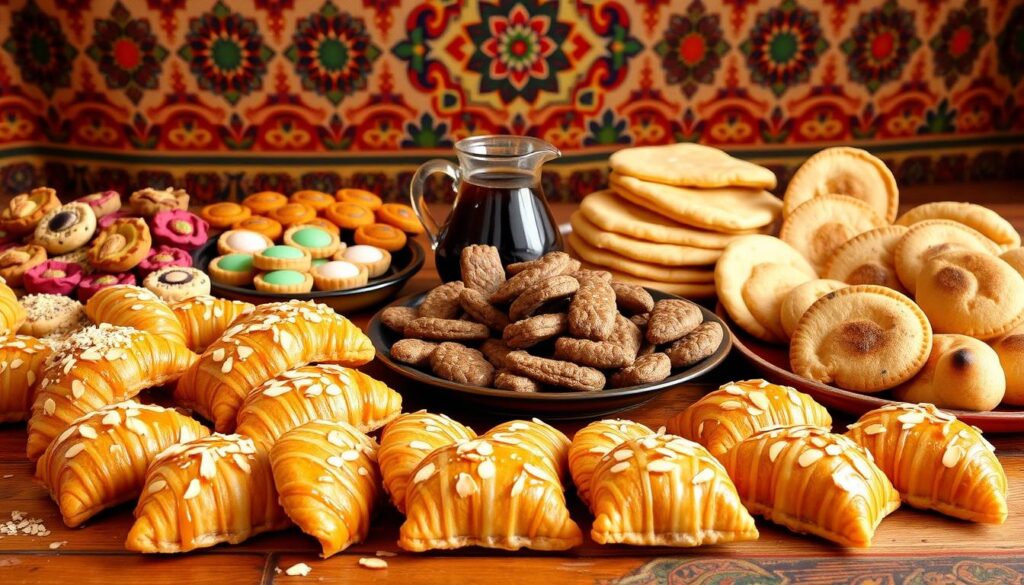
Mint Tea and Other Moroccan Beverages
Morocco’s beverage culture is characterized by the ubiquitous presence of mint tea, a drink that transcends mere refreshment. It is a staple of Moroccan hospitality and a symbol of the country’s rich cultural heritage.
The Ceremonial Art of Tea Preparation
The preparation of mint tea is a ceremonial art that involves a specific technique and a deep understanding of the ingredients. Green tea, fresh mint leaves, and sugar are the essential components. The tea is prepared in a teapot called a “berrada”, and the pouring of the tea is done from a height to create a frothy top, which is considered a sign of well-prepared tea.
Fruit Juices and Modern Drinks
While mint tea remains the most traditional and widely consumed beverage, modern Moroccan cuisine has also embraced fruit juices and other drinks. Popular options include orange juice, avocado smoothie, and salty lemonade, known as “lalamacha.” These drinks are refreshing and offer a unique twist on traditional flavors.
Cooking Moroccan Food at Home in America
Moroccan cuisine, with its rich flavors and aromas, can be easily recreated in American kitchens. The key to successful Moroccan cooking lies in understanding the essential pantry staples and being flexible with ingredient substitutions.
Essential Pantry Items for American Kitchens
To start cooking Moroccan food, you’ll need to stock your pantry with a few essential items. These include Ras el hanout, a blend of spices that translates to “head of the shop,” and preserved lemons, which add a salty, tangy flavor to dishes. Other staples are couscous, chickpeas, and olive oil.
| Pantry Staple | Use in Moroccan Cooking |
|---|---|
| Ras el hanout | Spice blend used in tagines and couscous dishes |
| Preserved Lemons | Adds salty, tangy flavor to tagines and salads |
| Couscous | Main staple grain, often served with vegetables and meat |
Adapting Recipes with Local Ingredients
While traditional Moroccan ingredients are ideal, adapting recipes to use local ingredients can be just as delicious. For example, substituting locally available vegetables like carrots and zucchini into a tagine recipe can yield fantastic results. As Chef Fatema Hal once said, “The beauty of Moroccan cooking lies in its flexibility and adaptability.”
“The art of cooking is not just about the food, it’s about the experience and the love you put into it.”
When adapting recipes, consider the flavor profiles you’re trying to achieve. For instance, if a recipe calls for lamb, you can substitute it with beef or chicken, adjusting the cooking time accordingly.
Conclusion: Embracing the Flavors of Morocco
As we conclude our culinary journey through Morocco, it’s clear that embracing Moroccan cuisine is about more than just savoring delicious dishes. It’s an immersive cultural culinary experience that combines rich heritage, unique flavors, and traditional cooking methods.
The flavors of Morocco, with their intricate blend of spices, herbs, and other ingredients, offer a sensory experience that transports you to the bustling markets and vibrant streets of Marrakech or Fez. From the iconic tagine to the national dish of couscous, every meal is a celebration of Morocco’s diverse culinary influences.
Embracing Moroccan cuisine means appreciating its cultural significance and the role it plays in bringing people together. Whether you’re cooking in a traditional tagine or experimenting with modern twists on classic recipes, the essence of Moroccan hospitality is about sharing meals and creating memories.
As you explore the world of Moroccan food, you’re not just adopting a new cuisine; you’re embracing a rich cultural heritage that welcomes everyone to the table. So, take the flavors of Morocco into your kitchen, and let the aromas and tastes transport you to a world of culinary delight.

